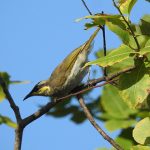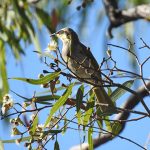MANGROVE HONEYEATOR
The Mangrove Honeyeater is a medium-sized bird, measuring around 20 to 25 centimetres in length. It sports a predominantly olive-green and grey plumage, with a strikingly streaked throat and chest that gives it a distinct appearance. This streaking helps it blend into the dappled light of its mangrove habitat, providing a natural camouflage against predators.
Originally, the Mangrove Honeyeater was primarily found along the eastern coast of Australia, from Townsville in Queensland to Northern New South Wales. However, recent observations have noted a southward expansion of its range. This shift might be attributed to changes in habitat conditions or climate, allowing the bird to explore new territories. It thrives in mangrove forests, which provide essential resources such as food, shelter, and nesting sites.
The bird is known for its sweet, melodic calls, which consist of a series of tinkling notes. These sounds are often described as cheerful and are crucial for communication, especially during the breeding season when attracting a mate becomes a priority.
The Mangrove Honeyeater primarily feeds on nectar. Its tongue is uniquely adapted with a brush-like tip, ideal for extracting nectar from flowers. Favouring the blossoms of mangrove trees and plays a crucial role in pollinating mangrove flowers, facilitating plant reproduction. Its diet is supplemented with insects and small arthropods, which are vital for providing protein, particularly during the breeding season when energy demands increase.
Breeding typically coincides with the flowering of mangroves, ensuring a steady food supply. The honeyeaters construct cup-shaped nests within dense foliage, which helps conceal them from predators. The female lays two to three eggs, and both parents are actively involved in feeding and caring for the chicks, ensuring their growth and survival.
While specific lifespan data for the Mangrove Honeyeater is limited, honeyeaters generally can live for several years in the wild. Their longevity is closely tied to the health and stability of their mangrove habitats.
Although not currently endangered, the Mangrove Honeyeater’s dependence on mangrove ecosystems makes it susceptible to habitat loss due to coastal development and climate change.
The Mangrove Honeyeater is a remarkable example of how wildlife adapts to and thrives in specific environments. Its gradual southward expansion is a testament to its resilience and the dynamic nature of ecosystems. By understanding and appreciating such species, we are reminded of the importance of conserving their natural habitats, ensuring their continued presence along Australia’s picturesque coastlines.


